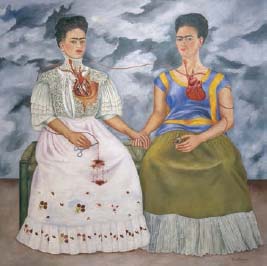The Modern World During and After the World Wars, C. 1914–1960Modern Art in Latin America |
Who was Frida Kahlo? |
Frida Kahlo (1907–1954) may have been married to Diego Rivera, but her style of painting was highly individual and eschewed the monumentality of many of her male counterparts who were part of the Mexican muralist movement. Kahlo’s autobiographical self-portraits had more in common with miniature paintings and she was highly influenced by Mexican folk painting. Although not officially considered a Surrealist, many of her paintings focus on themes of emotion and psychology through slightly disturbing, dream-like imagery. Her painting, The Two Fridas (1939), depicts two seated self-portraits, one dressed in a European-style dress and the other in traditional Mexico clothing, representing her dual heritage (her father was German and her mother was Mexican). The anatomically detailed hearts of both Fridas can be seen through their chests, each connected with a long, thin blood vessel that wraps around them. The Frida on the left holds a pair of scissors and she cuts the vessel, blood spilling from the tip. This is thought to represent both Aztec sacrifice and the life-long pain she suffered after a traumatic bus accident in 1925. Other famous works by Kahlo include Self-Portrait with Thorn Necklace (1940) and Self-Portrait on the Border Between Mexico and the United States (1932).

Frida Kahlo, who was married to Diego Rivera, was a Mexican artist who explored surrealist and personal themes in paintings such as The Two Fridas (1939). (Art courtesy The Bridgeman Art Library, © 2013 Banco de Mexico Diego Rivera Frida Kahlo Museums Trust, Mexico, D.F. / Artists Rights Society [ARS], New York.)
